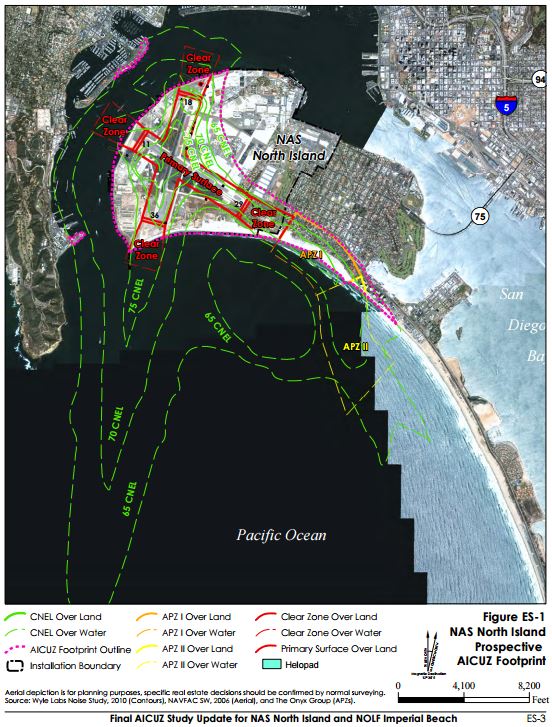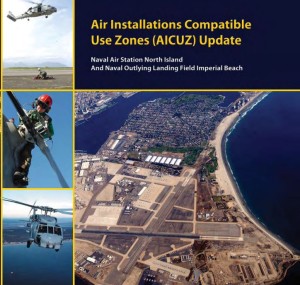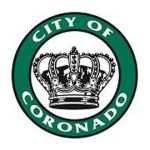When the Navy issued its Air Installations Compatible Use Zones (AICUZ) updated report in 2011, city officials went into panic mode. The report designated the runway approach to Naval Air Station North Island a crash zone and set noise and safety regulations that many in the city believed threatened the economy of the city.

After the report was issued many in the city thought that it would prevent people from remodeling or rebuilding their homes in the zone, which includes 415 homes, several businesses and 14 hotels, including the city’s most iconic structure, the Hotel del Coronado.
It turns out that this is not the case. “The new rules only apply to new development,” said Angie Jamison, Manager of Airport Planning.

It was a point she would return to over and over again at the three workshops the Airport Authority, acting as the Airport Land Use Commission, held at the Coronado Cays Yacht Club on Tuesday, March 22.
“People can knock a house down and rebuild it; they can add a room or a deck. An owner can do pretty much whatever he wants with his property as long as it complies with local zoning laws and the use of the property doesn’t change, for example you can’t tear down a single-family home and put up a condominium,” Jamison explained.
The workshop at the Cays was the first of nine planned to help draw the public into the creation of an Airport Land Use Compatibility Plan (ALUCP) for North Island Naval Air Station. Under state law it must be compatible with the AICUZ.
 That is why city officials panicked when the report was issued in 2011. At meetings held with the Navy and the airport commission at the time, stakeholders were told that homeowners would not be able to make any changes to their property.
That is why city officials panicked when the report was issued in 2011. At meetings held with the Navy and the airport commission at the time, stakeholders were told that homeowners would not be able to make any changes to their property.
“A nonconforming use cannot be expanded. This means that new homes could not be built on these 1,000 properties, except to replace in-kind current homes,” Mayor Casey Tanaka told the Union-Tribune at the time.
During the intervening years a new interpretation or understanding appears to have emerged.
“When I went to the early stakeholder meetings, the information was different from what we were told several years ago,” Councilwoman Carrie Downey said.
An ALUCP is not unlike a city’s general plan or zoning ordinances that determine character of a neighborhood, be it single-family homes, apartment complexes, commercial enterprises or all three.
An ALUCP sets these standards for land around airports to prevent noise- and risk-sensitive uses (hospitals and schools for example) from airport operations and to protect airports from encroachments that might interfere or restrict airport operations.
The San Diego Airport Land Use Commission will be prepare the plan with input from local elected-officials, a working-group that includes representatives from various stakeholders, including representatives the Navy, the City of Coronado, the Coronado Chamber of Commerce, and property owners in the crash zone. The general public will also have a voice in the process.
The commission has already set up public workshops to go over every aspect of the plan. The next workshop will be held on Wednesday, April 27 and focus on safety for example. All subsequent workshops will be held in the Winn Room of the Coronado Public Library from 5:30 pm to 6:30pm.
Attendance at the first meeting on March 22 was scanty. Only 36 people attended. There were three one-hour presentations starting at 4pm. The numbers dwindled from 16 to 9 as the evening wore on. This may have been due to the location and the time of day. Driving to the Cays during rush hour would be a disincentive for most people, Downey pointed out. She attended all three sessions.
“I wanted to make sure I understood what information the Airport Land Use Commission was telling our residents. I also wanted to understand our residents’ concerns,” she wrote in an e-mail following the meeting.
Once the plan is drafted, it will be subject to an environmental review. Again, public comments will be taken. Finally the Coronado City Council will review the plan. The whole process should be completed by mid-2018.
For more information on the ALUCP and the workshop schedule go to san.org/NASNI





